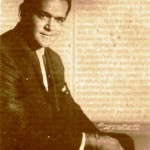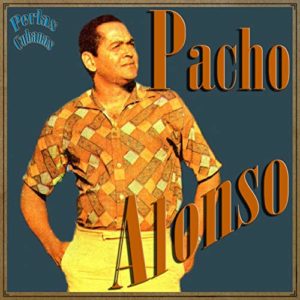 PACHO ALONSO, CANTANTE CUBANO QUE MARCO UN ESTILO PROPIO, DIRECTOR. VIDEOS.
PACHO ALONSO, CANTANTE CUBANO QUE MARCO UN ESTILO PROPIO, DIRECTOR. VIDEOS.
Conocido solo como “Pacho Alonso” nació con el nombre de Pascasio Alonso Fajardo en la ciudad de Santiago de Cuba, el 22 de agosto de 1928. Excelente vocalista de extraordinaria afinación, fraseo y métrica perfecta al cantar. creador de un estilo propio, lo mismo para cantar boleros que los ritmos bailables, especialmente el son. Fue también un sobresaliente director de orquesta y de diferentes agrupaciones musicales. Interpretaba una especie de estampas musicales costumbristas que relataban momentos y personajes de su ciudad natal. Llegó a marcar un estilo “a lo Pacho”.
Desde muy pequeño comenzó a hacer presentaciones con una compañía de teatro infantil que actuaba en el antiguo Teatro Coliseo de su ciudad natal. Su debut artístico profesional se produjo en 1945 en un programa de la emisora CMCK, en Santiago de Cuba, al sustituir a un hermano. Le siguieron entonces las presentaciones de la Cadena Oriental de radio CMKW.
Antes de ser artista, ejerció el magisterio y fue en las aulas de primaria donde comprendió que su verdadera vocación estaba en el escenario y el pentagrama. A los 18 años conoció a José Antonio Méndez, quien lo presentó en la conocida Emisora Mil Diez de La Habana. De regreso a Santiago concluyó los estudios de magisterio, sin abandonar sus actuaciones en Cadena Oriental de Radio.
Accedió al mundo soñado en 1951 al ser contratado como vocalista en la orquesta de Mariano Mercerón, ocasión en que grabó sus primeros discos. También eran cantantes de esta orquesta en esa época Fernando Álvarez y Benny Moré. Pacho era el cancionero; Fernando, el bolerista y Benny, la estrella; popularmente conocidos como Los tres Mosqueteros.
El primer grupo creado por el músico se denominó Pacho Alonso y sus Modernistas en 1952, con residencia en Santiago de Cuba. Esta agrupación se reestructuró cuatro años después y ya en La Habana cambió su nombre por el de Pacho Alonso y sus Bocucos y más tarde creó otra agrupación: Pacho Alonso y sus Pachucos.
A mediados de la década de los cincuenta grabó su primer disco: Cha-Cha-Cha de la Reina, exitosa creación de Enrique Bonne acompañado por la orquesta de Mercerón. En 1957 se radicó en la capital de la Isla, y amenizó bailables en centros nocturnos y sociedades de recreo; paralelamente se presentaba en radio y televisión. Cantó también en los carnavales capitalinos.
A fines de 1958, llegó a la cima de la popularidad con “Enfermo del Alma” y “Dame un chance” de Electo Rosell Chepín. Entre los éxitos más importantes de Pacho Alonso a lo largo de toda su carrera se incluyen “Yo no quiero piedra en mi camino”, de Enrique Bonne, y los boleros “Imágenes”, “Tú no sospechas” y “Nieblas del riachuelo”, temas grabados por la disquera RCA Víctor, que en 1960 le otorgó el Disco de oro por La Pachanga, de gran popularidad entonces en Cuba y otros países de la América Latina, principalmente Colombia. Una noche en el Scheherezada fue su primer disco de larga duración, en el que se muestra como uno de los más grandes cultivadores del bolero y enseguida le siguió “Que me digan feo”.
https://youtu.be/2gsZBm0jTt0
La agrupación Pacho Alonso y sus Bocucos trabajó estrechamente con Faustino Oramas, el Guayabero, Ibrahim Ferrer y Carlos Querol. Con Enrique Bonne, incorporó un nuevo ritmo: Pilón, modalidad con antecedentes en el órgano oriental, y toma su nombre del instrumento donde se descascara el café. En 1967 forma un nuevo grupo llamado Pacho Alonso y sus Pachucos, dando muestras de su gran versatilidad y destacada creatividad. El dueto Bonne-Alonso logró que nuevas modalidades gozaran de popularidad, como el ritmo Simalé y el UPA UPA, aunque nunca con el extraordinario éxito del Pilón.
Pacho Alonso cosechó aplausos viajando por varios países de América, Europa y África. A finales de los años setenta incorporó a su hijo Pachito, ya destacado pianista y arreglista, a quien entregó la conducción de la orquesta antes de su repentina muerte el 28 de agosto de 1982.
 PACHO ALONSO, CUBAN SINGER WHO MARKED HIS OWN STYLE, DIRECTOR.
PACHO ALONSO, CUBAN SINGER WHO MARKED HIS OWN STYLE, DIRECTOR.
Pascasio Alonso Fajardo better known as “Pacho Alonso” was born in the city of Santiago de Cuba, on August 22, 1928. Excellent vocalist of extraordinary tuning, phrasing and perfect metric when singing. creator of his own style, the same to sing boleros that danceable rhythms, especially the are. He was also an outstanding conductor and of different musical groups. He interpreted a kind of folk music prints that related moments and characters from his hometown. He came to mark a “Pacho” style.
From an early age, he began making presentations with a children’s theater company that performed in the former Colosseum Theater in his hometown. His professional artistic debut came in 1945 on a program of the CMCK radio station in Santiago de Cuba, replacing a brother. Then the presentations of the CMKW Oriental Radio Station followed.
Before becoming an artist, he practiced teaching and it was in the primary classrooms where he realized that his true vocation was on stage and the staff. At age 18 he met José Antonio Méndez, who presented him at the well-known Mil Diez Station in Havana. On his return to Santiago, he finished his teaching studies, without abandoning his performances in Eastern Radio Station.
He acceded to the dream world in 1951 when he was hired as a vocalist in the Mariano Mercerón orchestra when he recorded his first albums. Fernando Álvarez and Benny Moré were also singers of this orchestra at that time. Pacho was the songbook; Fernando, the bolerista and Benny, the star; popularly known as The Three Musketeers.
The first group created by the musician was named Pacho Alonso and his Modernists in 1952, residing in Santiago de Cuba. This group was restructured four years later and already in Havana, it changed its name to Pacho Alonso and his Bocucos and later created another group: Pacho Alonso and his Pachucos.
In the mid-fifties, he recorded his first album: Cha-Cha-Cha de la Reina, a successful creation of Enrique Bonne accompanied by the Mercerón orchestra. In 1957 he settled in the capital of the Island, and entertained dances in nightclubs and recreational societies; in parallel, it was presented on radio and television. He also sang in the carnivals of the capital.
At the end of 1958, he reached the peak of popularity with “Sick of the Soul” and “Give me a chance” by Electo Rosell Chepin. Among the most important successes of Pacho Alonso throughout his career include “I do not want stone in my way”, by Enrique Bonne, and the boleros “Images”, “You do not suspect” and “Fogs of the creek”, songs recorded by the RCA Víctor label, which in 1960 was awarded the Gold Record by La Pachanga, of great popularity then in Cuba and other Latin American countries, mainly Colombia. One night at the Scheherezade was his first full-length album, in which he is shown as one of the largest growers of the bolero and then followed “Let me be ugly.”
The Pacho Alonso group and their Bocucos worked closely with Faustino Oramas, the Guayabero, Ibrahim Ferrer and Carlos Querol. With Enrique Bonne, he incorporated a new rhythm: Pylon, a modality with a background in the eastern organ, and takes its name from the instrument where coffee is husked. In 1967 he formed a new group called Pacho Alonso and his Pachucos, showing his great versatility and outstanding creativity. The duet Bonne-Alonso made new modalities enjoy popularity, such as the Simalé rhythm and the UPA UPA, although never with the extraordinary success of the Pylon.
Pacho Alonso reaped applause traveling through several countries in America, Europe, and Africa. At the end of the seventies, he incorporated his son Pachito, already an outstanding pianist and arranger, to whom he gave the conduction of the orchestra before his sudden death on August 28, 1982.
Agencies/ Wiki/ Cubarte/ Internet Photos/ YouTube/ Arnoldo Varona/ www.TheCubanHistory.com
THE CUBAN HISTORY, HOLLYWOOD.



 < PACHO ALONSO, Cuban Singer who Marked his Own Style, Director. VIDEOS.
< PACHO ALONSO, Cuban Singer who Marked his Own Style, Director. VIDEOS.






